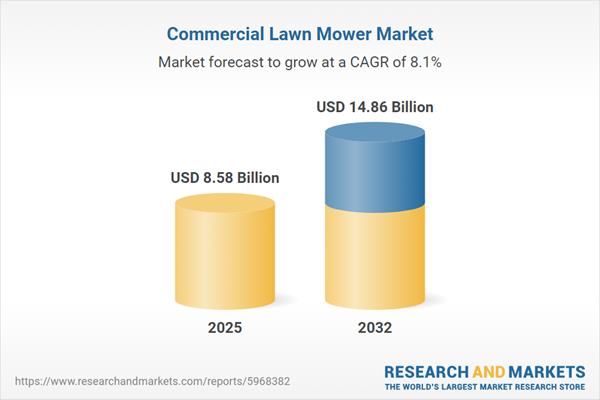Speak directly to the analyst to clarify any post sales queries you may have.
The commercial lawn mower market is undergoing significant change as organizations demand greater innovation, operational flexibility, and sustainable practices. Senior decision-makers who understand these market dynamics are better positioned to lead resilient, efficient landscaping strategies aligned with evolving industry expectations.
Market Snapshot: Growth and Development in the Commercial Lawn Mower Market
The commercial lawn mower market is currently valued at USD 7.96 billion in 2024 and projected to reach USD 8.58 billion by 2025, supported by an annual growth rate of 8.11%. By 2032, the sector is anticipated to achieve USD 14.86 billion.
Demand is driven by varied end users, including industrial, governmental, and educational organizations seeking advanced mower technologies. Both established companies and new entrants are focusing on sustainability, regulatory compliance, and integrated technologies to meet the rising expectations for high-performance, efficient, and responsibly manufactured equipment worldwide.Scope & Segmentation of the Commercial Lawn Mower Market
- Product Types: Offers hover mowers, robotic mowing platforms, walk-behind units, garden tractors, and zero-turn models—each designed for commercial use across sports venues, campuses, public parks, and municipal settings. This breadth ensures solutions for diverse property sizes and specific upkeep challenges.
- Power Sources: Includes battery-powered options (lithium-ion and lead-acid), gasoline, diesel, and hybrid engines. Organizations can select configurations balancing operational efficiency, emissions reduction, and adherence to local mandates.
- Engine Types: Features both four-stroke and two-stroke engines, meeting needs ranging from high-output mowing to quiet operation in sensitive areas like healthcare campuses or schools.
- Blade Types: Provides reel, rotary, and high-lift blade options. These choices support facility managers in optimizing turf care for varied grass species, surface conditions, and maintenance intervals.
- End Users: Caters to landscaping contractors, facility managers, grounds teams for educational institutions, municipal maintenance crews, and athletic complex operators—each prioritizing equipment versatility and large-area efficiency.
- Distribution Channels: Spans brick-and-mortar retailers, dedicated dealerships, and digital sales platforms, offering tailored procurement flexibility and timely service or parts support.
- Regional Coverage: Encompasses markets in the Americas, Europe, Middle East, Africa, and Asia-Pacific. Success depends on regional adaptation, given climate variations, regulatory requirements, and unique infrastructure considerations.
- Key Companies Profiled: Highlights leading providers such as Kubota Corporation, Husqvarna AB, AGCO Corporation, AL-KO Geräte GmbH, and John Deere Group, along with innovative emerging players bringing advanced technology and differentiated service models.
Key Takeaways: Strategic Guidance for Decision-Makers
- AI-enabled and autonomous mowing systems are driving consistent quality and operational efficiencies for organizations managing large or complex sites, reducing routine labor and supporting standardized outcomes.
- Sustainable design and manufacturing have become central, equipping organizations to more effectively address tightening emissions standards and future regulatory landscapes within their procurement plans.
- Battery and hybrid-powered equipment options help minimize operational noise and environmental impact, enabling service continuity in sensitive settings with strict compliance needs.
- Modular mower designs and strong after-sales support facilitate rapid adaptation to changing business models and evolving landscaping requirements while reducing equipment downtime.
- Digital fleet management tools are enhancing asset oversight, providing predictive analytics for more effective scheduling, maintenance, and lifecycle management at scale.
- Localized product adaptations and tailored support services help organizations maintain high performance and regulatory compliance as regional conditions shift.
Tariff Impact: Navigating Cost and Supply Realignment
Impending U.S. tariff adjustments for 2025 are prompting organizations to review procurement and supply strategies. Many are looking toward near-shore suppliers and modular equipment alternatives to mitigate the impact of shifting costs and potential supply chain disruptions.
Methodology & Data Sources
This commercial lawn mower market report is based on senior expert interviews, regulatory analysis, and detailed company case studies. Scenario modeling and benchmarking were applied to provide valuable insights for leaders managing commercial landscaping operations.
Why This Report Matters
- Enables senior leaders to align procurement and operations with emerging technologies and regulatory trends in the commercial lawn mower sector.
- Facilitates strategic investments and supports sustainable growth across both established and developing global markets.
- Delivers actionable frameworks for organizations seeking to strengthen decision-making and gain leadership advantage in a changing commercial landscape.
Conclusion
Prioritizing adaptive sourcing and proactive supplier relationships empowers organizations to navigate the evolving commercial landscaping environment. Leveraging this report drives more resilient asset management and forward-thinking operational planning to support business objectives.
Additional Product Information:
- Purchase of this report includes 1 year online access with quarterly updates.
- This report can be updated on request. Please contact our Customer Experience team using the Ask a Question widget on our website.
Table of Contents
3. Executive Summary
4. Market Overview
7. Cumulative Impact of Artificial Intelligence 2025
Companies Mentioned
The companies profiled in this Commercial Lawn Mower market report include:- Kubota Corporation
- Husqvarna AB
- AGCO Corporation
- AL-KO Geräte GmbH
- Andreas Stihl Pvt Ltd.
- AriensCo
- Bad Boy Mowers
- Bobcat Company by Doosan Group
- Briggs & Stratton, LLC
- EGO POWER
- Einhell Germany AG
- Greenworks North America, LLC
- Honda Motor Co., Ltd.
- iRobot Corporation
- Jacobsen by Textron Inc.
- John Deere Group
- Lastec LLC
- Makita Corporation
- Mamibot Manufacturing USA
- Masport Industries Limited
- Positec Tool Corporation
- Robert Bosch GmbH
- SCAG Power Equipment
- Stanley Black & Decker, Inc.
- Stiga S.p.A.
- Swisher Inc.
- The Toro Company
- Yamabiko Corporation
Table Information
| Report Attribute | Details |
|---|---|
| No. of Pages | 187 |
| Published | October 2025 |
| Forecast Period | 2025 - 2032 |
| Estimated Market Value ( USD | $ 8.58 Billion |
| Forecasted Market Value ( USD | $ 14.86 Billion |
| Compound Annual Growth Rate | 8.1% |
| Regions Covered | Global |
| No. of Companies Mentioned | 29 |









